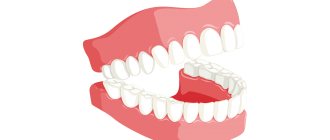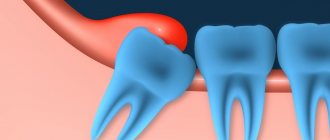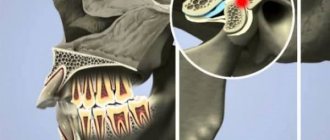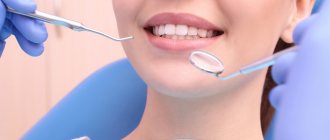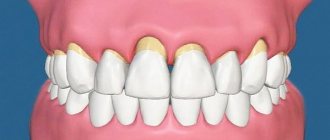| Appointment with a surgeon in Moscow on the same day of treatment | Reception is strictly by appointment, make an appointment by phone: +7 | Prices for services | Reviews about the clinic |
Abscess on the lip
- this is the formation of a purulent process that develops as a result of the penetration of pathogenic pathogens into the tissues of a given area. The starting mechanism for the formation of an abscess is trauma to the mucous membrane of the lips from the oral cavity or damage to the skin on the face. Another reason for the formation of deep abscesses is multiple pustular rashes on the face.
An abscess on the lip is an extremely dangerous condition, since the likelihood of its spreading throughout the cellular spaces is extremely high. Due to the intensive blood supply to the face, the spread of the purulent process to the infraorbital and buccal area occurs extremely quickly.
Make an appointment with a surgeon by phone or by filling out the online form
| Select a clinic | Abdominal ultrasound | Gastroenterologist | Calling a surgeon to your home |
Useful information on the topic:
- Abscess
- Abscess on the stomach
- Abscess of the buttocks
- Opening an abscess
- Abscess treatment
- Causes of abscess
What is an oral abscess?
An oral abscess is an acute inflammatory disease characterized by the formation and accumulation of pus in the tissues of the gums, tongue or cheeks. The abscess is accompanied by local swelling and hardening of soft tissues, severe pain on palpation, fever and general weakness. The disease is diagnosed by a dentist after a visual examination of the tissue, after which immediate surgical intervention is required: opening the abscess, followed by cleaning and taking anti-inflammatory drugs.
Oral abscess is one of the most common complications in the practice of dental surgery. It can be observed in patients of different ages. Untimely treatment can lead to the transition of inflammation to the chronic stage. Against this background, sepsis and phlegmon can develop. That is why, if the slightest symptoms of an abscess occur, you should immediately visit a dentist.
Types of ulcers that may appear on the lip
The formation of a boil on the upper or lower lip is usually preceded by swelling and moderate pain. In the first couple of days, swelling and redness occur. Following them, a bubble with an abscess appears. Typically, patients complain of pain when trying to touch the tumor. If you do not respond to the symptom in time and do not start treatment, the boil will begin to fester. Sometimes, along with other symptoms, the patient’s health noticeably worsens and the temperature rises.
When herpes occurs, swelling appears
If this is a manifestation of herpes, then a blister with a clear liquid usually appears on the lip, which becomes covered with a crust after 3-4 days. This also causes itching, a feeling of tightness and pain. It is easier to stop an exacerbation of a viral infection if you start treatment at the reddening stage.
“Oh, I’m already tormented with this herpes. As soon as you get into a draft, it immediately pops up on your lip. All my life I have been saving myself with Acyclovir, as for me, they haven’t come up with anything better. By the way, regular toothpaste dries well, a proven old-fashioned method.”
Lenka1989, from correspondence on the woman.ru forum
Aphtha is an abscess inside the lip. Such rashes usually appear on the mucous membrane, and can be recognized by their white heads. As a rule, this is a sign of aphthous stomatitis, which can develop in both adults and children. In this case, neoplasms can be localized not only on the lips, but also on the inside of the cheeks and even on the tongue.
This is what aftas look like
Sometimes a lipoma is mistaken for a boil, but this is a pathological phenomenon of a completely different nature. This is a benign neoplasm, which is a dense node that forms inside the soft tissue. Essentially, this is a cavity filled with dead epithelial cells and fatty contents. Its removal is carried out surgically.
Types of abscess by location
An abscess is classified based on the location of the inflammation. The following types of pathology are distinguished:
Gum abscess The most common type, inflammation forms near a specific tooth. If left untreated, an abscess can provoke: leakage of pus from the formed fistula, putrid odor from the mouth and intoxication of the body. Abscess of the floor of the mouth Forms under the tongue, which causes severe pain and discomfort during communication or eating. When the abscess spontaneously opens, the infected fluid pours into the oral cavity and can provoke a new outbreak in the pharynx and neck. Abscess of the palate Occurs against the background of uncured or previous periodontitis of the teeth of the upper jaw. In the future, inflammation can spread to the peritonsillar region and other tissues of the palate, leading to osteomyelitis of the palatal plate. Cheek abscess The depth of damage to this area of the mucosa determines the localization of inflammation, which can sit inside the cheek or extend to the outer surface. Such abscesses are extremely dangerous, because the infection can affect nearby facial organs and tissues. Tongue Abscess Obvious signs include a swollen tongue, pain during meals, and difficulty communicating and breathing. This type of abscess, according to doctors, is the most dangerous and requires immediate treatment.
Types of rashes
A neoplasm on the mucous membrane on the outside of the lower or upper lip may have a different appearance based on the cause that contributed to its occurrence. In most cases, a preliminary diagnosis can be made based on external clinical manifestations.
White pimple
A white pustule is an omentum or a closed comedon, which does not pose a threat to the health of its owner. It is formed due to blockage of the sebaceous gland duct by keratinized epidermis or sebum.
The surface of the lip itself does not suffer:
When white pimples are localized on the outer or inner area of the lips, on the mucous membranes of the mouth, or on the tongue, we can indirectly speak of stomatitis, which requires competent therapy.
In the photo there is stomatitis on the lower lip:
Purulent abscess
Increased production of sebum, excessive accumulation of keratinized epithelium, which is complemented by the addition of a secondary infection, is characterized by the appearance of an abscess. When a white tubercle forms in the center of the neoplasm, we can talk about the complete maturation of the abscess. After the breakthrough, the damaged area begins to heal.
An abscess can also be a boil, which forms against the background of an inflammatory process in the hair follicle and nearby sebaceous glands. In common parlance they are called boils. Most often they occur in areas with vellus hair - on the face, limbs.
A serious pathology is a carbuncle - a neoplasm that forms against the background of inflammation of several hair follicles and sebaceous glands located next to each other. In addition to the nasolabial triangle, such growths appear on the neck, back, and buttocks.
Lipoma
This is not a pimple or an abscess at all, but sometimes, without understanding it, they try to squeeze it out, which is completely useless. A dense and immobile lump under the skin is considered a benign neoplasm - a lipoma, which can be localized on the outskirts of the lip. It is formed by fatty exudate mixed with dead epithelial cells.
Such growths are not dangerous, however, if they are located on the lip, there is an increased risk of injury, for example, during kissing, cosmetic manipulation, or chewing.
READ ALSO: Treatment of eczema - Medical portal EUROLAB
Causes of development of abscess in the oral cavity
An abscess in the oral cavity occurs as a complication of advanced periodontal disease and periodontitis. These diseases are characterized by damage to the teeth and gums with the subsequent formation of pockets in the periodontium. They accumulate pathogenic microorganisms that provoke inflammation. Among other things, an abscess can occur due to infection in a damaged area of soft tissue (trauma, syringe needle, instrument). The cause of the disease is often staphylococcal and streptococcal sore throats, as well as boils on the face.
Inflammation in the oral cavity also appears as a complication after suffering from influenza or ARVI, which weaken the immune system, as a result of which the body is not able to fight infection.
We know how to cure ORAL ABSCESS
In the near future, a medical coordinator will contact you and advise you on the conditions and cost of treatment, select a doctor and make an appointment for you.
| Make an appointment | Or call us +375 29 699-03-03 +375 33 319-03-03 |
Stomatitis varieties
There is probably no person who has not experienced the appearance of disgusting sores, be it an abscess on the lip inside or in another place.
All of them have been studied, and doctors have divided them into the following types:
- Herpes blisters appear inside the mouth filled with a white substance. They bother you with their itching and burning sensation in the lips.
- Candidiasis plaques are formed from a yeast fungus. Usually it is peacefully located in the human microflora. When a favorable provocation is applied, the fungus begins to multiply intensively, covering the mucous membrane inside the mouth and on the lips with a white coating.
- The internal membranes are also captured by the aphthae. These bacteria are more serious, and if at first a small abscess appears in the form of a bubble, then after it deforms, a circle with a white dot in the middle forms, with bloody borders. A person feels weak from elevated temperature, blood is released from the gums, swelling appears with increased sensitivity in the mouth.
- The following sores speak for themselves by their name; these are allergic rashes. They can be caused by any product or medicinal substance that has come into contact with the oral cavity. But the sensations are deplorable from swelling, red mucous membranes, and inflammation. Round formations rupture and erosion appears.
- Traumatic ulcers can be characterized by the following type of abscesses in the mouth from burns, injuries, and poor-quality dentures.
- Bacterial stomatitis affects people from infection with infectious diseases through wounds, cracks, and microorganisms multiply in them.
To avoid infection of the lips and mucous areas, careful hygiene is necessary, it is important to monitor the condition of the teeth and carry out special rinses.
Symptoms
The abscess is characterized by rapid development. At first, the patient may be bothered only by minor attacks of pain, similar to the sensations that arise during caries or periodontitis. Subsequently, the pain is localized in one place and gradually increases. In a specific place there is swelling, sometimes a new formation on the gum, sometimes reaching the size of a walnut. If the inflammation is localized closer to the outer surface, then swelling and redness can be observed with the naked eye. If you notice the first symptoms, we recommend that you consult a dentist.
An abscess of the tongue is characterized by an increase in the organ's volume, difficulty swallowing, chewing, and even suffocation. Any abscess is accompanied by fever, deterioration and general weakness, insomnia, and loss of appetite. The progression of the disease leads to a breakthrough of the abscess, which is manifested in a decrease in temperature, a decrease in swelling and an improvement in overall well-being. However, there is no reason to stop treatment, since inflammation can continue and develop into a chronic form. This can lead to tooth loss, sepsis and phlegmon.
What can cause an abscess on the lip? Possible causes and treatments
The appearance of a neoplasm in the form of a boil on the lip should at least alert you. Under no circumstances should you try to squeeze out such pustules yourself or pierce them. Otherwise, this may lead to the spread of purulent exudate throughout the adjacent soft tissues and, accordingly, to the development of complications. To understand how to get rid of such an unpleasant phenomenon, you first need to establish the cause of its occurrence. And for this it is better to contact a specialist. Read further in this article about why an abscess may appear on the inside or outside of the lip and what to do about it.
Treatment of oral abscess
Treatment of an abscess requires surgery. In order to eliminate the source of infection and stop the spread of inflammation, the dental surgeon step by step:
- opens an abscess;
- drains the cavity;
- cleans the pocket;
- Rarely applies stitches if the size of the incision is large.
After removal of the pus, the patient’s well-being improves, and facial geometry is restored. Taking antibiotics, antihistamines, immunostimulants and a vitamin complex significantly speeds up the healing process. Sometimes the doctor may prescribe physiotherapeutic procedures (UHF therapy and fluctuarization).
For some time, the patient needs to exclude solid foods from the diet and adhere to healthy eating rules.
Pustules on the labia with molluscum contagiosum
A small nodule is formed, dense to the touch.
The formation has a depression in the middle.
Infection with molluscum contagiosum occurs through the use of other people's personal hygiene items, close contact, and sex.
Molluscum contagiosum can cause formations that look like pustules.
When squeezed out, the contents are whitish in color.
HPV provokes spontaneous cell division at the site of infection by the virus.
Characteristic formations begin to appear in this area, but no pain occurs.
Over time, the formations grow and resemble cauliflower in appearance.
At first they can be confused with pustular elements.
Remember! If pustular rashes appear, you should visit a doctor.
Prognosis and prevention of oral abscess
The success of treating oral abscesses depends on at what stage of the disease the patient seeks help and how strong the body’s defense mechanism is. With timely treatment, the prognosis for eliminating inflammation is quite favorable. In the absence of complications, strong immunity and a high-quality opening of the lesion, an oral abscess can be cured in a couple of weeks.
Prevention of the disease consists of following the following recommendations:
- regular teeth cleaning and professional oral hygiene at least once every six months;
- minimizing the risk of injury to the mucous membrane;
- timely treatment of caries and periodontal diseases;
- visiting a dentist for a preventive examination once every 6 months.
Pustules on the labia with syphilis
Pustules on the labia appear as a result of infection by the pathogen Treponema pallidum.
Upon examination, they look like acne.
Diagnosis is difficult with syphilis, without a laboratory base.
To confirm, a blood test is most often taken.
When pustules appear, be sure to check when the last time you had sexual intercourse.
Syphilis is accompanied by enlargement of regional lymph nodes.
Syphilis rashes are not accompanied by itching and pain.
Characteristic will be the absence of clearly manifested inflammation at the site of the abscess.
Diagnosis and treatment of inflammation of the external genitalia
The diagnosis can only be made by a gynecologist. At the same time, no special diagnostics are needed at the first stage. The doctor will immediately notice inflammation during a routine gynecological examination. Next, the doctor determines the cause of the inflammation, after which a treatment regimen is selected.
Depending on the cause of the development of the pathology - an allergic factor, injury, incorrectly selected underwear - it is enough to simply limit the direct contact of the provoking agent with the organs and apply symptomatic therapy (local treatment that relieves unpleasant symptoms). You can easily identify this cause by donating blood for allergies. The analysis will show the cause due to the presence in the blood of special antibodies that are formed only during allergic reactions.
When diagnosing the infectious nature of the disease, microbiological culture is carried out on nutrient media in order to identify the causative agent and the correct selection of antibiotic therapy. To do this, the gynecologist takes swabs from the genital tract and sends them to the laboratory.
There, they first determine the type of infection, and then test different drugs on the samples. Since almost all pathogens of sexual diseases easily adapt to medications, choosing pills that will help you completely recover is not easy. Sometimes specialists go through up to a dozen different medications.
Unfortunately, inflammation is rarely caused by a single pathogen; more often, the cause is a whole bunch of infections, starting with thrush and ending with gonorrhea. In such cases, it will not be enough to simply take smears - the examination will continue further. You will have to donate blood for syphilis, hepatitis and undergo a pelvic ultrasound, as the process quickly spreads through the genital tract, affecting internal organs.
Diagnosis of gynecological abscesses
The diagnostic process begins with identifying the patient's disturbing symptoms and complaints. After the interview, the doctor conducts a gynecological examination by palpation and using gynecological speculum. Some genital abscesses (for example, bartholinitis) can be diagnosed during a gynecological examination. Others require more in-depth diagnostics - laboratory and instrumental studies.
The doctor gives a referral to donate blood and urine for general and specific laboratory tests (CBC, OAM, tests for sexually transmitted infections), which can identify various viruses and inflammatory processes. Hardware research methods include computed tomography and transvaginal ultrasound.
general characteristics
Pain in the labia area is most often observed in acute and chronic specific and nonspecific infectious diseases. Other possible causes are degenerative and atrophic changes, allergic reactions. With local inflammatory processes, there is a danger of upward spread of infection with damage to the vagina, cervix and body of the uterus, ovaries and fallopian tubes. Exogenous factors contributing to the development of this group of pathologies are:
- neglect of hygiene;
- mechanical injuries to the labia during sexual intercourse, using pads for too long, wearing rough and tight clothing;
- chemical irritation and skin damage due to the use of inappropriate hygiene products or attempts at self-medication;
- abuse of antibiotics, irrational use of hormonal contraceptives, radiation therapy.
Endogenous disorders that create favorable conditions for the occurrence of inflammatory and atrophic processes in this area include:
- metabolic and hormonal disorders: decreased estrogen levels, diabetes, obesity, deficiency of vitamins and minerals;
- urethro-vaginal, vesicovaginal and rectovaginal fistulas;
- skin diseases: psoriasis, perineal eczema;
- helminthic infestations, intestinal dysbiosis.
